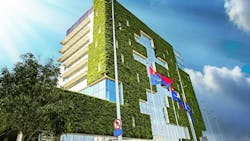Regenerative design focuses on how projects are constructed to improve the built environment through sustainable design.
What is Sustainable Design?
Sustainable design is widely accepted as good. Sustainability means the use of a resource in a way that the “resource is not depleted or permanently damaged." Put another way, Equiterra regenerative design defines true sustainability as “having no negative operational impact on the environment.” While such efforts are difficult to achieve, the design industry is making strides to create sustainable design—but is it enough?
Paul Hutton, principal and director of regenerative design for the architectural firm Cuningham, wrote about the shift away from design that’s solely sustainable, “Regenerative design seeks to not merely lessen the harm of new development, but rather to put design and construction to work as positive forces that repair natural and human systems.”
Sustainable design has been a buzzword for three decades and according to Architecture 2030, the United States saw a 27% decline in building sector CO2 emissions from 2005 to 2020. Total global floor area increased by 17% between 2010 and 2017, with energy use rising only 6%. Despite these successes, sustainable design is not the best option as the design industry and other fields explore regenerative design and circular design (no waste) options.
How Do You Make Architecture Regenerative?
“The art or science of building” is a common definition for architecture that Jacob Littman, a University of Massachusetts Amherst graduate student, argues is incomplete. Architecture is not just the building but also the place, so he proposes a new definition of architecture: “the art or practice of designing and constructing place, through the integration of site and building.”
Reframing sustainable design as regenerative design seeks to lessen the harm of new development as well as design and construction projects that repair natural and human systems. An approach to comprehend this repair process is by examining regenerative building certifications like the Living Building Challenge, crafted by the International Living Future Institute (ILFI). The ILFI’s certification includes seven petals of the Living Building Challenge that ask, what if every building was as efficient as a flower? Those petals are place, water, energy & carbon, health & happiness, materials, equity and beauty.
ILFI defines living buildings as regenerative structures that connect dwellers to light, air, food, nature and community; self-sufficient and function within the resource limits of the site; and positively impact the human and natural systems they interact with.
Key Elements of Regenerative Design
Employing regenerative design practices includes several factors that promote the continuous renewal of societal and ecological functions, such as these six considerations proposed by global architecture firm HDR.
- Net-positive impacts: Regenerative design integrates cutting-edge approaches that mirror natural ecological systems to improve wellness and uses community-focused social equity solutions.
- Adjusts to project types and sizes: Applicable to projects of various scales, types and performance standards, the regenerative design aims for net-positive impacts across carbon, water, nutrients, air, biodiversity, social well-being and health factors.
- Follows unique site data and is metric-based: Indicators obtained from an untouched reference site and its natural performance help define a regenerative project’s objectives. The metrics are determined through geographical information system (GIS) maps, data from federal agencies, academic institutions and reputable social and ecological research.
- Design shifts and refreshes: The use of projection modeling of performance indicators like air quality, carbon emissions, water usage, nutrient cycles, biodiversity, health and social wellbeing are dynamic and can change. The socio-ecological system changes based on short-term and long-term disruptions that need to be projected throughout the project.
- Incorporating existing paradigms: Regenerative design includes paradigms that build toward true regenerative design performance levels: triple net-zero, carbon balancing, health and wellness design, materials transparency, resiliency and social equity.
- Community involvement: Stakeholder involvement is crucial to align community values with the project’s objectives. These conversations help strategize for the future co-evolution of socio-ecological systems.
About the Author
Lauren Brant
Buildings Editor
Lauren Brant is the editor of Buildings. She is an award-winning editor and reporter whose work appeared in daily and weekly newspapers. She strives to create content that is informative and actionable for professionals, helping them discover new products, technology, and insights to make smarter building decisions. In 2020, the weekly newspaper won the Rhoades Family Weekly Print Sweepstakes—the division winner across the state's weekly newspapers. Lauren was also awarded the top feature photo across Class A papers. She holds a B.A. in journalism and media communications from Colorado State University-Fort Collins and a M.S. in organizational management from Chadron State College.

